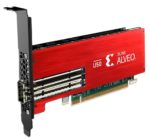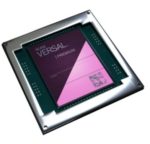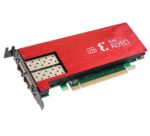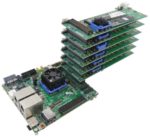Today, Intel pledged an additional $50 million in a pandemic response technology initiative to combat the coronavirus through accelerating access to technology at the point of patient care, speeding scientific research and ensuring access to online learning for students. Included in Intel’s effort is an additional innovation fund for requests where access to Intel expertise and resources can have immediate impact. “We hope that by sharing our expertise, resources and technology, we can help to accelerate work that saves lives and expands access to critical services around the world during this challenging time.”
Xilinx Alveo U50 Accelerator Cards come to Nimbix Cloud with Broad Application Support
Today Nimbix announced the availability of Xilinx Alveo U50 Accelerator Cards on the Nimbix Cloud. “Nimbix has paved the way for FPGA-accelerated cloud computing and today leads with the broadest portfolio of cloud FPGA solutions in the industry,” said Steve Hebert, CEO of Nimbix. “The availability of U50 accelerators in the Nimbix Cloud and JARVICE XE are helping ISVs and developers bring new applications and solutions to market in the cloud.”
Ayar Labs, DARPA and Intel Replace Electronic I/O with Efficient Optical Signaling
Researchers from Intel and Ayar Labs working on PIPES have successfully replaced the traditional electrical input/output (I/O) of a state-of-the-art field programmable gate array (FPGA) with efficient optical signaling interfaces. The demonstration leverages an optical interface developed by Ayar Labs called TeraPHY, an optical I/O chiplet that replaces electrical serializer/deserializer (SERDES) chiplets. “FPGAs with photonic interfaces will have broad impact, improving high-performance computing, artificial intelligence, large-scale emulation, and DoD-specific capabilities such as advanced radars.”
Xilinx Announces Versal Premium ACAP for Network and Cloud Acceleration
Today Xilinx announced Versal Premium, the third series in the Versal ACAP portfolio. The Versal Premium series features highly integrated, networked and power-optimized cores and the industry’s highest bandwidth and compute density on an adaptable platform. Versal Premium is designed for the highest bandwidth networks operating in thermally and spatially constrained environments, as well as for cloud providers who need scalable, adaptable application acceleration.
Xilinx SmartNIC Accelerates Network, Storage, and Compute on Single Device
Today Xilinx announced the industry’s first SmartNIC platform delivering true convergence of network, storage and compute acceleration functions on a single device. “The U25 combines a highly optimized SmartNIC platform with a powerful and flexible FPGA-based engine that supports full programmability and turnkey accelerated applications. The U25 delivers a comprehensive SmartNIC platform to address the industry’s most challenging demands and workloads such as SDN, virtual switching, NFV, NVMe-oF, electronic trading, AI inference, video transcoding, and data analytics.”
Video: FPGAs and Machine Learning
James Moawad and Greg Nash from Intel gave this talk at ATPESC 2019. “FPGAs are a natural choice for implementing neural networks as they can handle different algorithms in computing, logic, and memory resources in the same device. Faster performance comparing to competitive implementations as the user can hardcore operations into the hardware. Software developers can use the OpenCL device C level programming standard to target FPGAs as accelerators to standard CPUs without having to deal with hardware level design.”
An Alternative to OpenMP and an On-Ramp to Future C++ Standards
In this edition of Let’s Talk Exascale, Christian Trott of Sandia National Laboratories shares insights about Kokkos, a programming model for numerous Exascale Computing Project applications. “Kokkos is a programming model being developed to deliver a widely usable alternative to programming in OpenMP. It is expected to be easier to use and provide a higher degree of performance portability, while integrating better into C++ codes.”
Cisco to Acquire Exablaze
Cisco is announcing its intent to acquire Exablaze, a privately held, Australia-based designer and manufacturer of advanced network devices. Exablaze’s design and manufacturing innovation offer customers the latest Field Programmable Gate Array (FPGA) technology with the required flexibility and programmability for environments where ultra-low-latency and high performance is critical. These next-generation products include advanced ultra-low latency FPGA-based switches and network interface cards (NICs), as well as picosecond resolution timing technology. “In the case of the high frequency trading sector, every sliver of time matters. By adding Exablaze’s segment leading ultra-low latency devices and FPGA-based applications to our portfolio, financial and HFT customers will be better positioned to achieve their business objectives and deliver on their customer value proposition.”
Aldec’s new FPGA-based NVMe Data Storage Targets HPC Applications
Today Aldec, Inc. launched a powerful, versatile and time-saving FPGA-based NVMe Data Storage solution to aid in the development of High Performance Computing applications such as High Frequency Trading and Machine Learning. “NVMe SSDs are very popular in a wide range of high-performance computing applications, as are FPGAs because of their ability to handle parallel processing, their speed and programmability, plus the fact MPSoC FPGAs also feature ARM processor cores,” comments Louie De Luna, Director of Marketing. “Our newest FPGA-based embedded solution is aimed at engineers developing systems that will combine the power and benefits of NVMe and FPGAs.”
Cortical.io Demonstrates Real-time Semantic Supercomputing for NLU
Today Cortical.io announced the debut of a new class of high-performance enterprise applications based on “Semantic Supercomputing.” Semantic Supercomputing combines Cortical.io AI-based NLU software inspired by neuroscience with hardware acceleration to create new solutions to understand and process streams of natural language content at massive scale in real time. “We are taking the concept of supercomputing to the next level with the introduction of Semantic Supercomputing and the ability to deliver real-time processing of semantic content.”













